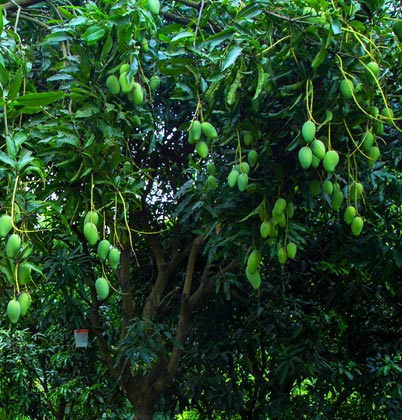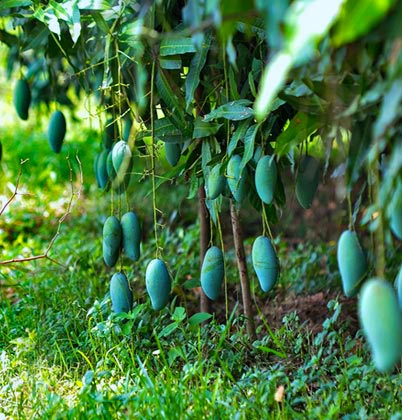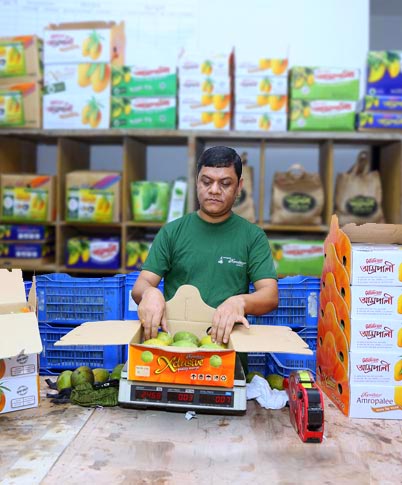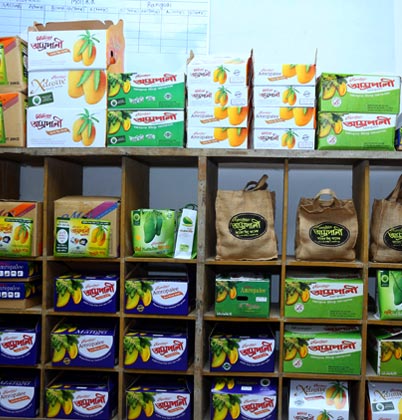The main fruit that is grown on our plantations is mango. Varieties, include:
| Early | Thai Kanchamitha, Thai Namdokmai, Thai Rainbow, Thai Banana, Poniya, Thai Sornali |
|---|---|
| Mid-season | Amropalee, Mallika, Rangui, Himsagor, Shundori, Thai Okla |
| Late | Ashini, Gouromoti, Vadhuri, Shurjopuri, Lota Bombay, Haribangha, Thai Mohasen. |
*Amropalee is a mango variety which was introduced in 1971 in India and introduced in 2004 for the first time in Bangladesh by Meridian.

There are a range of commercial mango varieties grown in Meridian Agro Industries for the domestic and export markets. Based on time of ripening, varieties may be classified as under:
| Early | Thai Kanchamitha, Thai Namdokmai, Thai Rainbow, Thai Banana, Poniya, Thai Sornali |
|---|---|
| Mid-season | Amropalee, Mallika, Rangui, Himsagor, Shundori, Thai Okla |
| Late | Ashini, Gouromoti, Vadhuri, Shurjopuri, Lota Bombay, Haribangha, Thai Mohasen. |

Soil
Mangoes can be grown successfully in a wide range of soils, but a healthy, high-yielding plantation is only possible on fertile, deep and well-drained soils on high to medium highland, at pH 5.5-7.5 and water table below 180 cm year round.
Planting Seeds:
Our all the gardens are on hilly areas based on square or rectangular contour system which is very suitable at our hilly areas. One year old seedling obtained through vegetative propagation that are strong, stout, and free from any diseases.
Propagation:
Mango can be raised from seed propagated. Seed propagation is now restricted to raising rootstocks, which are not true to type. To raise rootstock, freshly extracted stones from mature and ripe fruits are sown in beds in lines. These seedlings remain there for a year. When they attain a suitable thickness and height they are propagated asexually by side or veneer either in beds or shifted to a suitable seized earthen or polythene bags and grafted by inarching.
Duration of Flowering
Flowering begins from the end of December to the end of January at every year.
Watering / Irrigation:
- The soil is dried out for 2 or 3 months before the flowering stage to promote better flower formation. This phenomenon is attributed to a simultaneous stimulation of growth during the autumn months which, in turn, influences flower formation in spring.
- Fruit drop, the size and quality is also influenced by time and method of irrigation. Irrigation during the developmental stage of the fruit is essential to prevent fruit drop and to promote the development of a young fruit. Additional irrigation during ripening improves both fruit size and quality.
- Regular spray is maintained and essential. The annual water requirement (with no rainfall) of mature mango trees is 11 000 m3/ha/year. Additional care during flower bud development (May to July) is beneficial. This adds up to 9 500 m3/ha/year. The seasonal water usage of trees not subject to additional water stress, varies from 20 to 44 m3/ha/day from June to November respectively.
We maintain regular spray.
Moreover, the annual water requirement (with no rainfall) of mature mango trees is 11 000 m3/ha/year. Some degree of stress during flower bud development (May to July) is, however, advantageous. Water usage of trees subjected to water stress during flower-bud development is 9 500 m3/ha/year. The seasonal water usage of trees not subject to water stress, varies from 20 to 44 m3/ha/day from June to November respectively.
Duration of Fruit Setting
Usually the fruit sets during February. Harvesting occurs between May to July.
Harvesting
Mango trees need continuous attention in order to ensure continued harvests and to improve the lifespan of the orchard trees. Mangoes reach maturity after 4 to 5 months from flowering. Fruits of "smudged" trees ripen several months before those of untreated trees.
Working with Thai Experts & Consultants have lead to the usage of Pheromones. When it is sprayed within 54 days after full bloom, mangoes can be harvested in a shorter time period than recommended minimum maturity. The result on this innovation is that despite being harvest 2 weeks before untreated fruits, the mangoes are larger and heavier. If sprayed at 68 days after full bloom and harvested 2 weeks after spraying, there is an improvement in quality due to soluble solids and tractable acidity. Pheromone Traps curbing fruit flies without the use of formalin.
Sorting
After harvesting, mangoes are sorted. Currently we sort fruits by hand. This is done through subjective analysis of physical and morphological characteristics of fruits. However, we are implementing new sorting technology that will further allow us to ensure that the best product reaches our consumers with adequate shelf life. This will also allow for more robust classification and will place the percentage of unsellable mango at only 10-15%.

Hot water treatment
Our experts and researchers concentrated on a technology safe for both health and environment while having the minimum negative effect on fruit quality. Use of heated water is more safe and effective in meeting the quarantine requirements.
For this treatment, fruit must be immersed in hot water at 52 - 54°C for 2- 3 minutes to eradicate any unwanted substances such as insect/pests, germ or fungus. Temperature is closely monitored for effectiveness of the treatment and to avoid any damage to the mangoes.
This cost effective method makes the mangoes safe to eat and store.
Dryer / Blower Program
The sap which leaks from the stem bums the skin of the fruit, making black lesions which lead to rotting. Therefore the fruit is immediately dried and wiped using a special blower system and cotton pads.Our aim is to go above hygienic standards and prevent damage to our products.

Fruits are graded according to size, color and maturity. While grading, smaller fruits are separated from the larger ones in order to achieve uniform ripening. An additional level of sorting is done, as immature, overripe, damaged and diseased fruits are discarded in the process.
Meridian Agro created a grading system according to the end consumers needs and wants. The proposed mango grading system follows these steps:
- Size Calculation
- Maturity Identification
- Determination of surface defects
- Result and discussion
We maintain international standard having Exclusive and Premium sizes of mangos.
Mangoes are boxed and naturally ripened using straw and paper. Carbide, a poison and formalin, which are harmful when consumed are never used. We take pride in using organic methods.
The mature green fruits can be stored at room temperature for about 4-10 days in the early stage depending upon the variety. The harvested fruits are pre-cooled to 10-120C and then stored at an appropriate temperature.
Mallika and Amropalee varieties are stored at 120 C, Lehengra at 140 C, 85-90 % relative humidity.
The effects of harvesting maturity mangoes on storage tinder various low-temperature regimes and the influence of storage on quality development during subsequent ripening at higher temperatures. The capacity for storage of mango fruit depended on harvest maturity, storage temperature, and the time of harvest within the season. Development of peel and pulp color, soluble solids concentration, pH, and softening in during storage for up to 4days at 120 C. Based on the level of ripening change that occurred 120 C storage, immature fruit showed superior storage capacity than fruit harvested at more-advanced stages of physiological maturity. On transfer to ripening temperatures (25C); however, immature fruit failed to develop full ripeness characteristics.
Mature and half-mature fruit underwent limited ripening during storage at 12C, the extent of which increased with progressive harvests during the season. Ripening changes during storage for 10days were less at 8 and 10C than at 12C. Chilling injury, as indicated by inhibition of ripening, was found at all harvest stored at 8C, and in early season harvests stored at 10C. Fruit from mid- and late-season harvests stored better at 10 than at 12C, with no apparent signs of chilling injury. Flavor of mangos ripened after low-temperature storage was less acceptable than of those ripened immediately after harvest. Suggestions are made for maximizing storage potential by controlling harvest maturity and storage temperature for progressive harvests throughout the season.
Box
- Exclusive – 2kg (Easy Carry)
- Premium – 3kg (Easy Carry)
- Premium – 3kg (Regular Box)
- Exclusive – 5kg (Easy Carry)
- Premium – 5kg (Regular Box)
- Exclusive – 10kg (Carton)
- Premium – 10kg (Carton)
Shopping Bag
- Shopping Bag (Cloth made) – 3kg
- Jute Bag – 3kg
- Shopping Bag (Jute Bag) –3kg
- Shopping Bag (Paper) – 1kg (Only for KanchaMitha)
The most commonly used containers are ventilated plastic racks of corrugated fiber or rice straw carton box. Size of the box varies to accommodate 20-25kg of fruit on mango varieties.

Transportation
Our orchards are easily accessible via road. Mangoes are sent to the market on road, in cover vans.
Marketing
Marketing of the mangoes is mainly controlled by intermediaries like wholesalers and our own agents.


